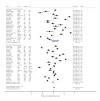Antibiotic prescription practices in primary care in low- and middle-income countries: A systematic review and meta-analysis
- PMID: 32544153
- PMCID: PMC7297306
- DOI: 10.1371/journal.pmed.1003139
Antibiotic prescription practices in primary care in low- and middle-income countries: A systematic review and meta-analysis
Abstract
Background: The widespread use of antibiotics plays a major role in the development and spread of antimicrobial resistance. However, important knowledge gaps still exist regarding the extent of their use in low- and middle-income countries (LMICs), particularly at the primary care level. We performed a systematic review and meta-analysis of studies conducted in primary care in LMICs to estimate the prevalence of antibiotic prescriptions as well as the proportion of such prescriptions that are inappropriate.
Methods and findings: We searched PubMed, Embase, Global Health, and CENTRAL for articles published between 1 January 2010 and 4 April 2019 without language restrictions. We subsequently updated our search on PubMed only to capture publications up to 11 March 2020. Studies conducted in LMICs (defined as per the World Bank criteria) reporting data on medicine use in primary care were included. Three reviewers independently screened citations by title and abstract, whereas the full-text evaluation of all selected records was performed by 2 reviewers, who also conducted data extraction and quality assessment. A modified version of a tool developed by Hoy and colleagues was utilized to evaluate the risk of bias of each included study. Meta-analyses using random-effects models were performed to identify the proportion of patients receiving antibiotics. The WHO Access, Watch, and Reserve (AWaRe) framework was used to classify prescribed antibiotics. We identified 48 studies from 27 LMICs, mostly conducted in the public sector and in urban areas, and predominantly based on medical records abstraction and/or drug prescription audits. The pooled prevalence proportion of antibiotic prescribing was 52% (95% CI: 51%-53%), with a prediction interval of 44%-60%. Individual studies' estimates were consistent across settings. Only 9 studies assessed rationality, and the proportion of inappropriate prescription among patients with various conditions ranged from 8% to 100%. Among 16 studies in 15 countries that reported details on prescribed antibiotics, Access-group antibiotics accounted for more than 60% of the total in 12 countries. The interpretation of pooled estimates is limited by the considerable between-study heterogeneity. Also, most of the available studies suffer from methodological issues and report insufficient details to assess appropriateness of prescription.
Conclusions: Antibiotics are highly prescribed in primary care across LMICs. Although a subset of studies reported a high proportion of inappropriate use, the true extent could not be assessed due to methodological limitations. Yet, our findings highlight the need for urgent action to improve prescription practices, starting from the integration of WHO treatment recommendations and the AWaRe classification into national guidelines.
Trial registration: PROSPERO registration number: CRD42019123269.
Conflict of interest statement
I have read the journal's policy and the authors of this manuscript have the following competing interests: MP is a member of the Editorial Board of PLOS Medicine, and he co-edits the PLOS Tuberculosis Channel.
Figures



References
-
- World Health Organization; Antimicrobial resistance and primary health care. Geneva: World Health Organization; 2018. [cited 2020 May 13]. Available from: https://apps.who.int/iris/bitstream/handle/10665/326454/WHO-HIS-SDS-2018....
-
- Review on Antimicrobial Resistance. Tackling drug-resistant infections globally: final report and recommendations London: Review on Antimicrobial Resistance; 2016. [cited 2020 May 13]. Available from: https://amr-review.org/sites/default/files/160518_Final%20paper_with%20c....
-
- World Health Organization. Global action plan on antimicrobial resistance. Geneva: World Health Organization; 2015. [cited 2020 May 13]. Available from: https://apps.who.int/iris/bitstream/handle/10665/193736/9789241509763_en.... - PubMed
Publication types
MeSH terms
Substances
LinkOut - more resources
Full Text Sources
Medical
Miscellaneous

